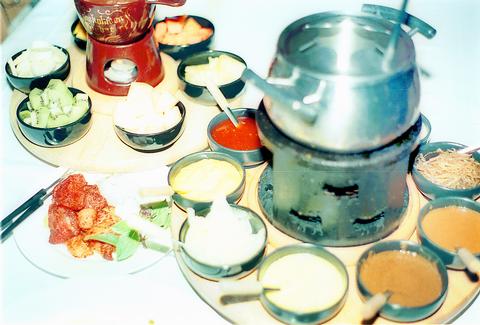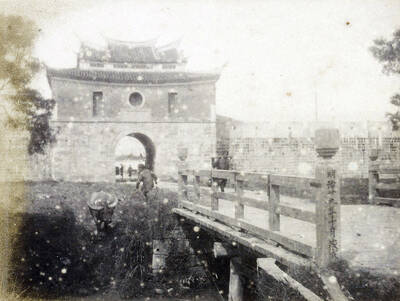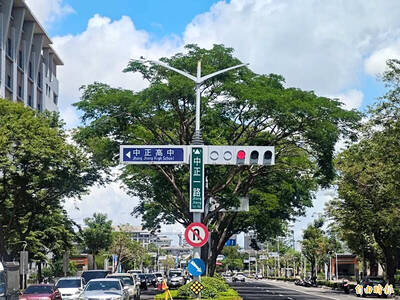Ticino prides itself on being an "authentic Swiss restaurant," and rightfully so, given the quaint Swiss decor found throughout this delightful eatery and its extensive menu of alpine delicacies.
Ticino has adhered steadfastly to its motto of providing genuine Swiss cuisine, unaltered for the sake of local taste buds, which often find cheese overpowering. So, with fondue being perhaps Switzerland's most famous dish, this specialty can sometimes prove a hard sell for the uninitiated, says manager Charles Ponsford. Those familiar with fondue, to whom this restaurant clearly caters, will immediately recognize the delicately combined flavors of white wine and melted Gruyere cheese over cubes of homemade bread. Another popular cheese fondue option is prepared with beer instead of wine, while the cheese-based Swiss specialty raclette is served as both an appetizer (NT$250) and a main dish (NT$380).
In a class all by itself is the fondue Bourguignonne (NT$750), which comes with hearty portions of US prime beef, chicken, prawns, french fries and mushrooms to deep fry in an oil broth. Top each fried chunk with a choice of six sauces, the most outstanding of which is the homemade Bearnaise sauce.

PHOTO: MAX WOODWORTH
Like Switzerland, Ticino provides a regional mix of German, French and Italian flavors. Eight different pasta dishes starting at NT$250 are the cheapest main dishes on the menu, while a classically Germanic element is provided in the smoked pork loin, bacon and sausage served on sauerkraut (NT$450). For meat lovers, Ponsford recommends the pan-fried veal escalope with sage and parma ham served on saffron rice (NT$650). To fully appreciate the house's celestial Bearnaise sauce, try the whole roasted beef filet (NT$700, for two).
Though most of its dishes can hardly be described as light fare, the menu also provides a number of lighter seafood dishes and substantial appetizers. Highly recommended are the pan-fried salmon steak with saffron rice (NT$550) and the sole meuniere (NT$750). The Swiss barley soup (NT$130) comes loaded with diced carrots and celery in a delicious chicken stock.
One of the highlights of any meal at Ticino is the excuse to indulge in a chocolate fondue for dessert. Dip a variety of freshly sliced fruit into rich melted chocolate and wash the whole down with sweet cherry liqueur. The taste is so authentically Swiss, one almost expects to peer out the window and see grazing cows and sprouting edelweiss.
Address: 2, Ln. 82, Tienmou E. Rd., Taipei (台北市天母東路82巷2號)
Telephone: (02) 2876-1101
Open: 11am - 2pm, 5pm - 9:30pm
Average meal: NT$600
Details: English menu. Credit cards accepted.

June 9 to June 15 A photo of two men riding trendy high-wheel Penny-Farthing bicycles past a Qing Dynasty gate aptly captures the essence of Taipei in 1897 — a newly colonized city on the cusp of great change. The Japanese began making significant modifications to the cityscape in 1899, tearing down Qing-era structures, widening boulevards and installing Western-style infrastructure and buildings. The photographer, Minosuke Imamura, only spent a year in Taiwan as a cartographer for the governor-general’s office, but he left behind a treasure trove of 130 images showing life at the onset of Japanese rule, spanning July 1897 to

One of the most important gripes that Taiwanese have about the Democratic Progressive Party (DPP) is that it has failed to deliver concretely on higher wages, housing prices and other bread-and-butter issues. The parallel complaint is that the DPP cares only about glamor issues, such as removing markers of Chinese Nationalist Party (KMT) colonialism by renaming them, or what the KMT codes as “de-Sinification.” Once again, as a critical election looms, the DPP is presenting evidence for that charge. The KMT was quick to jump on the recent proposal of the Ministry of the Interior (MOI) to rename roads that symbolize

On the evening of June 1, Control Yuan Secretary-General Lee Chun-yi (李俊俋) apologized and resigned in disgrace. His crime was instructing his driver to use a Control Yuan vehicle to transport his dog to a pet grooming salon. The Control Yuan is the government branch that investigates, audits and impeaches government officials for, among other things, misuse of government funds, so his misuse of a government vehicle was highly inappropriate. If this story were told to anyone living in the golden era of swaggering gangsters, flashy nouveau riche businessmen, and corrupt “black gold” politics of the 1980s and 1990s, they would have laughed.

In an interview posted online by United Daily News (UDN) on May 26, current Chinese Nationalist Party (KMT) Chairman Eric Chu (朱立倫) was asked about Taichung Mayor Lu Shiow-yen (盧秀燕) replacing him as party chair. Though not yet officially running, by the customs of Taiwan politics, Lu has been signalling she is both running for party chair and to be the party’s 2028 presidential candidate. She told an international media outlet that she was considering a run. She also gave a speech in Keelung on national priorities and foreign affairs. For details, see the May 23 edition of this column,